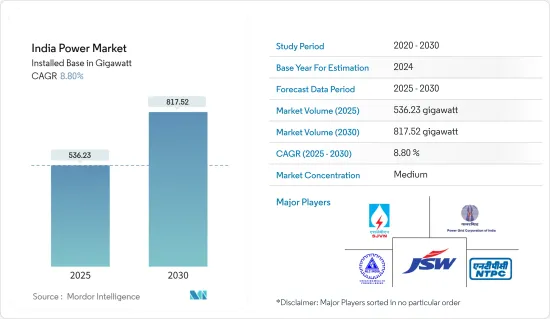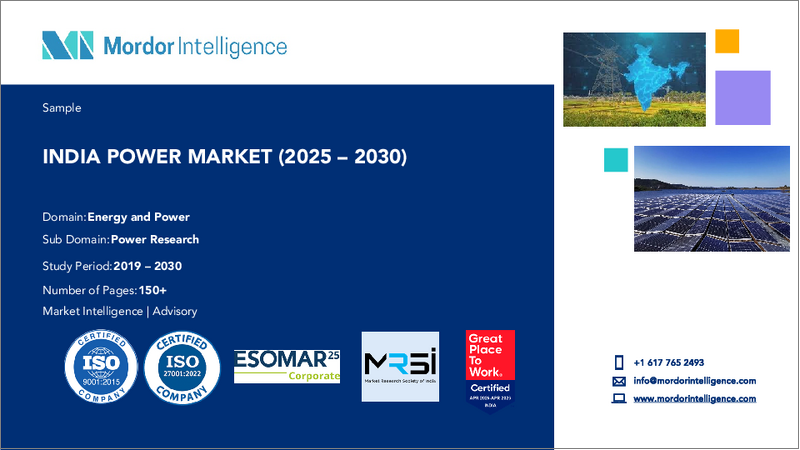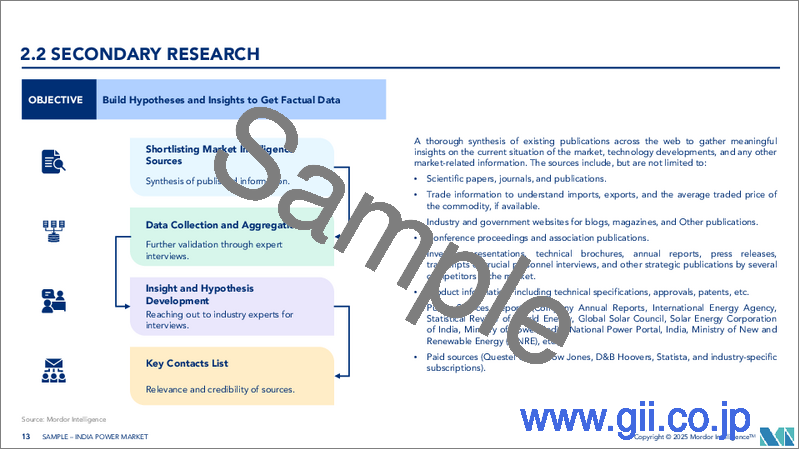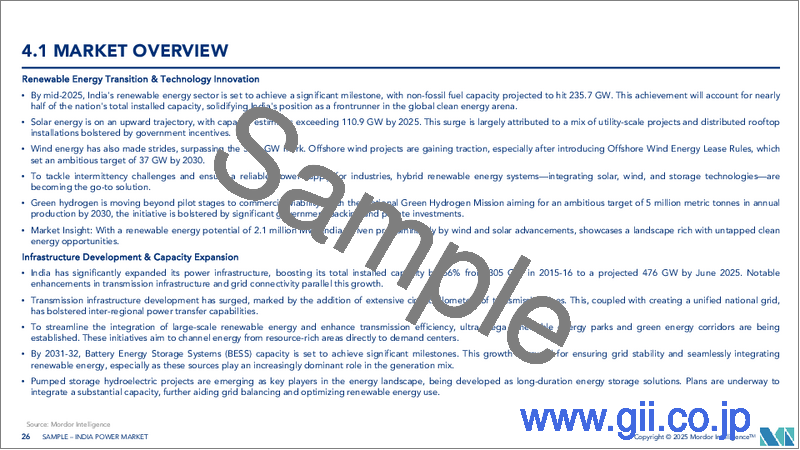|
|
市場調査レポート
商品コード
1686579
インドの電力:市場シェア分析、産業動向・統計、成長予測(2025~2030年)India Power - Market Share Analysis, Industry Trends & Statistics, Growth Forecasts (2025 - 2030) |
||||||
カスタマイズ可能
適宜更新あり
|
|||||||
| インドの電力:市場シェア分析、産業動向・統計、成長予測(2025~2030年) |
|
出版日: 2025年03月18日
発行: Mordor Intelligence
ページ情報: 英文 95 Pages
納期: 2~3営業日
|
全表示
- 概要
- 目次
概要
インドの電力市場規模は、2025年の536.23ギガワットから2030年には817.52ギガワットに拡大し、予測期間(2025~2030年)のCAGRは8.8%と予測されます。

主なハイライト
- 中期的には、政府の支援政策、インフラ整備による電力需要の増加、人口増加などの要因が予測期間中の市場を牽引するとみられます。
- 一方、発電、送電、配電網の設置と近代化には莫大な投資が必要であり、民間部門の投資が弱いことがインドの電力市場の成長を妨げると予想されます。
- しかしながら、インドには豊富な太陽放射照度があり、年間を通じて太陽エネルギーを受け入れています。このため、特にラジャスタン州、グジャラート州、アンドラ・プラデシュ州など、国内で最も日照量の多い場所から太陽エネルギーを利用する絶好の機会が生まれています。外国からの投資や大規模な電力プロジェクトと相まって、上記の要因がインドの電力市場を成長させる好機となっています。
インドの電力市場動向
火力発電が市場を独占
- インドには石炭が大量に埋蔵されており、発電用燃料として入手しやすく、比較的安価です。石炭の埋蔵量が多いため、インドは主要な生産国であると同時に消費国でもあり、火力発電所は増大する電力需要を満たすための魅力的な選択肢となっています。
- さらに、インドには石炭火力発電のためのインフラが確立されています。数多くの炭鉱、輸送網、石炭火力発電所がすでに稼働しています。こうした既存のインフラが、火力発電市場の優位性を支える基盤となっています。
- さらに2022年9月、インド・エネルギー省は、増大する電力需要に対応するため、2030年までに56GWもの石炭火力発電容量を追加する準備を進めていると発表しました。この石炭火力発電容量の増加は、現在の285の石炭火力発電所による204GWの石炭燃料発電を約25%上回ることになります。
- 2023年11月現在、インドは火力発電に大きく依存しており、総設備容量は2390.7万kWで、国内の発電容量の56%以上を占めています。
- また、火力発電所、特に石炭を使用する発電所は、再生可能エネルギーなどの代替エネルギーと比較してコスト競争力があります。火力発電所設立のための初期設備投資は、しばしば低額であり、燃料費を含む運転コストは、変動しやすい石油・ガス価格に比べて比較的安定しています。
- 火力発電所は、安定した信頼性の高い電力供給を行うことができるため、ベースロード需要(消費者の日常的なニーズを満たすために最低限必要な電力)を満たすのに適しています。安定した電力供給が可能であることが、市場における火力電源の優位性につながっています。
- したがって、上記の通り、予測期間中は火力発電部門が市場を独占する可能性が高いです。
政府の政策と支援が市場を牽引する見込み
- 政府の政策と支援は、電力セクターの成長に必要な明確なロードマップ、財政的インセンティブ、規制の枠組み、インフラ開発を提供するため、インドの電力市場の重要な促進要因です。再生可能エネルギー、エネルギー効率、グリッド統合、デジタル化を推進することで、政府は投資を呼び込み、イノベーションを促進し、インドの持続可能で信頼性の高い電力市場への移行を促進する環境を作り出しています。
- インド政府は、エネルギーミックス全体に占める自然エネルギーの割合を高めるため、野心的な自然エネルギー目標を設定しています。国家太陽光発電ミッション(National Solar Mission)、国家風力発電ミッション(National Wind Energy Mission)、様々な州レベルの再生可能エネルギー政策などの政策は、再生可能エネルギー発電プロジェクトの開発にインセンティブを与え、支援しています。これらのイニシアチブは、投資を誘致し、規制プロセスを合理化し、財政的インセンティブを提供し、再生可能エネルギーの成長に有利な環境を確保することを目的としています。
- 国の持続可能な変革を促進するため、政府は2030年までに再生可能エネルギー設備容量500ギガワット(GW)を達成するという、非常に大きな目標を掲げています。この目標には、太陽光発電が280GW、風力発電が140GWの導入が含まれ、国全体で重要なグリーン革命を推進することを目指しています。
- 2022年現在、インドの再生可能エネルギー設備容量は162GWを超え、2021年の147GWと比較して、再生可能エネルギーの適応が進んでいることを示しており、結果としてインドの電力市場を牽引しています。
- 2023年3月、インドは再生可能エネルギー部門拡大のための明確な道筋を描き、その成長のための明確なロードマップを示しました。このビジョンの一環として、インドは2024年3月までに、合計発電容量40ギガワットのウルトラメガソーラーパークの設立に取り組んでいます。この野心的なイニシアチブは、再生可能エネルギーのインフラを拡大し、持続可能な未来を育むというインドの揺るぎない献身を示しています。
- さらに政府は、再生可能エネルギー導入とエネルギー効率化対策を促進するために、さまざまな財政的インセンティブや補助金を提供しています。これには、資本補助金、発電量ベースのインセンティブ、税制優遇、譲許的融資、実行可能性ギャップ資金などが含まれます。このようなインセンティブは、再生可能エネルギープロジェクトを財政的に魅力的なものにし、電力市場への民間セクターの参入を促します。
- 従って、上記の通り、政府の支援政策が予測期間中の市場を牽引すると予想されます。
インドの電力産業の概要
インドの電力市場は半固定的です。この市場の主要企業(順不同)には、NTPC Ltd、NLC India Ltd、SJVN Ltd、JSW Group、Power Grid Corporation India Ltdなどがあります。
その他の特典
- エクセル形式の市場予測(ME)シート
- 3ヶ月間のアナリストサポート
目次
第1章 イントロダクション
- 調査範囲
- 市場の定義
- 調査の前提
第2章 調査手法
第3章 エグゼクティブサマリー
第4章 市場概要
- イントロダクション
- 2028年までのインド発電設備容量予測
- 発電設備容量の州別シェア(%)(2022年)
- 2028年までのインドの発電・消費量予測(単位:テラワット時)
- 最近の動向と開発
- 政府の規制と政策
- 市場力学
- 促進要因
- エネルギー需要の増加
- 電力セクターに対する政府の支援
- 抑制要因
- 財政能力
- 促進要因
- サプライチェーン分析
- PESTLE分析
第5章 市場セグメンテーション
- 電力別
- 火力
- 水力
- 再生可能エネルギー
- その他
- 送電・配電
第6章 競合情勢
- M&A、合弁事業、提携、協定
- 主要企業の戦略
- 企業プロファイル
- Adani Group
- JSW Group
- NHPC Ltd
- NLC India Ltd.
- NTPC Ltd.
- Power Grid Corporation India Ltd.
- Reliance Power Limited
- SJVN Ltd.
- Tata Power Company Limited
- Torrent Power Ltd.
第7章 市場機会と今後の動向
- 再生可能エネルギーの成長
目次
Product Code: 52852
The India Power Market size in terms of installed base is expected to grow from 536.23 gigawatt in 2025 to 817.52 gigawatt by 2030, at a CAGR of 8.8% during the forecast period (2025-2030).

Key Highlights
- Over the medium period, factors such as supportive government policies, rising electricity demand due to infrastructural activities, and rising population are expected to drive the market during the forecasted period.
- On the other hand, huge investment is required to set up and modernize power generation, transmission & distribution networks, and weak private sector investments are expected to hinder the growth of the Indian power market.
- Nevertheless, India has abundant availability of solar irradiance and receives solar energy throughout the year. This has created enormous opportunities to exploit solar energy from the sunniest sites in the country, especially Rajasthan, Gujarat, and Andhra Pradesh. The factor above, clubbed with foreign investment and extensive power projects, provides an opportunity to grow the power market in India.
India Power Market Trends
Thermal Source for Power Generation to Dominate the Market
- India has significant coal reserves, a readily available and relatively affordable fuel source for power generation. The country's large coal reserves have made it a major producer and consumer, making thermal power plants an attractive option for meeting the growing electricity demand.
- Moreover, India has a well-established infrastructure for coal-based thermal power generation. Numerous coal mines, transportation networks, and coal-fired power plants are already operating. This existing infrastructure provides a foundation for the market's dominance of thermal power generation.
- Furthermore, in September 2022, the Ministry of Energy India announced that the country is preparing to add as much as 56 GW of coal-fired generation capacity by 2030 to meet the growing electricity demand. The increase in coal-fired capacity would represent about a 25% jump above the country's current 204 GW of coal-fueled generation from 285 coal thermal power plants.
- As of November 2023, India heavily relies on thermal power sources for generating electricity, with a total installed capacity of 239.07 GW, accounting for more than 56% of the country's electricity generation capacity.
- Additionally, thermal power plants, especially those using coal, have been cost-competitive compared to alternative sources such as renewable energy. The initial capital investment for setting up thermal power plants is often lower, and the operating costs, including fuel costs, have been relatively stable compared to volatile oil and gas prices.
- Thermal power plants can provide a consistent and reliable supply of electricity, making them suitable for meeting the base load demand, which is the minimum level of power required to meet the everyday needs of consumers. The ability to provide a stable power supply has contributed to the dominance of thermal sources in the market.
- Therefore, as mentioned above, the thermal power sector will likely dominate the market during the forecasted period.
Government Policies and Support are Expected to Drive the Market
- Government policies and support are crucial drivers of the Indian power market as they provide a clear roadmap, financial incentives, regulatory frameworks, and infrastructure development necessary for the sector's growth. By promoting renewable energy, energy efficiency, grid integration, and digitalization, the government creates an enabling environment that attracts investments, fosters innovation, and facilitates the transition toward a sustainable and reliable power market in India.
- The Indian government has set ambitious renewable energy targets to increase the share of renewables in the overall energy mix. Policies such as the National Solar Mission, National Wind Energy Mission, and various state-level renewable energy policies provide incentives and support for developing renewable power projects. These initiatives aim to attract investments, streamline regulatory processes, provide financial incentives, and ensure a favorable environment for renewable energy growth.
- To catalyze a sustainable transformation in the nation, the government has established a formidable objective of achieving 500 gigawatts (GW) of installed renewable energy capacity by 2030. This target encompasses the installation of 280 GW from solar power and 140 GW from wind power sources, aiming to drive a significant green revolution across the country.
- As of 2022, the country has more than 162 GW of installed renewable energy capacity compared to 147 GW in 2021, signifying the increasing adaption of renewable energy in the country, consequently driving the power market in India.
- In March 2023, India charted a definitive path for expanding its renewable energy sector, outlining a clear roadmap for its growth. As part of this vision, the country is committed to establishing Ultra Mega Solar Parks with a combined generation capacity of 40 gigawatts by March 2024. This ambitious initiative demonstrates India's steadfast dedication to scaling up its renewable energy infrastructure and fostering a sustainable future.
- Additionally, the government offers various financial incentives and subsidies to promote renewable energy deployment and energy efficiency measures. These include capital subsidies, generation-based incentives, tax benefits, concessional financing, and viability gap funding. Such incentives make renewable projects financially attractive and encourage private sector participation in the power market.
- Therefore as per the above mentioned point, supportive government policies are expected to drive the market during the forecasted period.
India Power Industry Overview
The Indian power market is semi-consolidated. Some key players in this market (not in a particular order) include NTPC Ltd, NLC India Ltd, SJVN Ltd, JSW Group, and Power Grid Corporation India Ltd.
Additional Benefits:
- The market estimate (ME) sheet in Excel format
- 3 months of analyst support
TABLE OF CONTENTS
1 INTRODUCTION
- 1.1 Scope of the Study
- 1.2 Market Definition
- 1.3 Study Assumptions
2 RESEARCH METHODOLOGY
3 EXECUTIVE SUMMARY
4 MARKET OVERVIEW
- 4.1 Introduction
- 4.2 India Installed Power Generating Capacity Forecast, till 2028
- 4.3 Share of Installed Power Generation Capacity (%), by State, India, 2022
- 4.4 Electricity Generation and Consumption Forecast, in Terawatt Hours, India, till 2028
- 4.5 Recent Trends and Developments
- 4.6 Government Policies and Regulations
- 4.7 Market Dynamics
- 4.7.1 Drivers
- 4.7.1.1 Increasing Energy Demand
- 4.7.1.2 Government Support for Power Sector
- 4.7.2 Restraints
- 4.7.2.1 Financial Viability
- 4.7.1 Drivers
- 4.8 Supply Chain Analysis
- 4.9 PESTLE Analysis
5 MARKET SEGMENTATION
- 5.1 Generation
- 5.1.1 Thermal
- 5.1.2 Hydro
- 5.1.3 Renewable
- 5.1.4 Others
- 5.2 Transmission and Distribution
6 COMPETITIVE LANDSCAPE
- 6.1 Mergers and Acquisitions, Joint Ventures, Collaborations, and Agreements
- 6.2 Strategies Adopted by Leading Players
- 6.3 Company Profiles
- 6.3.1 Adani Group
- 6.3.2 JSW Group
- 6.3.3 NHPC Ltd
- 6.3.4 NLC India Ltd.
- 6.3.5 NTPC Ltd.
- 6.3.6 Power Grid Corporation India Ltd.
- 6.3.7 Reliance Power Limited
- 6.3.8 SJVN Ltd.
- 6.3.9 Tata Power Company Limited
- 6.3.10 Torrent Power Ltd.
7 MARKET OPPORTUNITIES AND FUTURE TRENDS
- 7.1 Renewable Energy Growth





